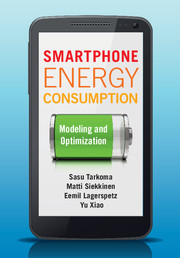Book contents
- Frontmatter
- Contents
- Preface
- List of abbreviations
- Part I Understanding energy consumption
- Part II Energy management and conservation
- 6 Overview
- 7 Smartphone subsystems
- 8 Mobile operating systems
- 9 Power modeling
- 10 Power profilers
- Part III Advanced energy optimization
- Appendix A An energy profile application
- Index
- References
9 - Power modeling
from Part II - Energy management and conservation
Published online by Cambridge University Press: 05 August 2014
- Frontmatter
- Contents
- Preface
- List of abbreviations
- Part I Understanding energy consumption
- Part II Energy management and conservation
- 6 Overview
- 7 Smartphone subsystems
- 8 Mobile operating systems
- 9 Power modeling
- 10 Power profilers
- Part III Advanced energy optimization
- Appendix A An energy profile application
- Index
- References
Summary
Our studies of power measurement have revealed that the power consumption of a smartphone varies with the applications in use, the way the device user uses the applications, and the environment where the smartphone is operated. As power measurement only tells us how much energy is being consumed by the whole smartphone or a hardware component such as the display, more information is required for analyzing the factors that affect the power consumption.
Power modeling is a technique that has been developed for quantifying the impact of different factors using mathematical models. A power model can be specified for a certain hardware component, a certain smartphone, or a certain piece of software. The information used for defining the model variables can be provided by hardware, OS, and/or applications, while the coefficients of these variables can be derived from power measurement using deterministic and/or statistical methods. The methodology of deterministic and statistical power modeling is introduced in Section 9.1, followed by three case studies: a deterministic power model of a Wi-Fi network interface (Section 9.2), a statistical model of the overall power consumption of a smartphone (Section 9.3), and a fine-grained energy profiler using system call traces (Section 9.4).
Power models can be used for estimating the energy consumption of the hardware or software component. Examples of model-based energy profilers can be found in Chapter 10. More importantly, power models provide hints on improving the energy efficiency of smartphones and applications.
- Type
- Chapter
- Information
- Smartphone Energy ConsumptionModeling and Optimization, pp. 162 - 191Publisher: Cambridge University PressPrint publication year: 2014



